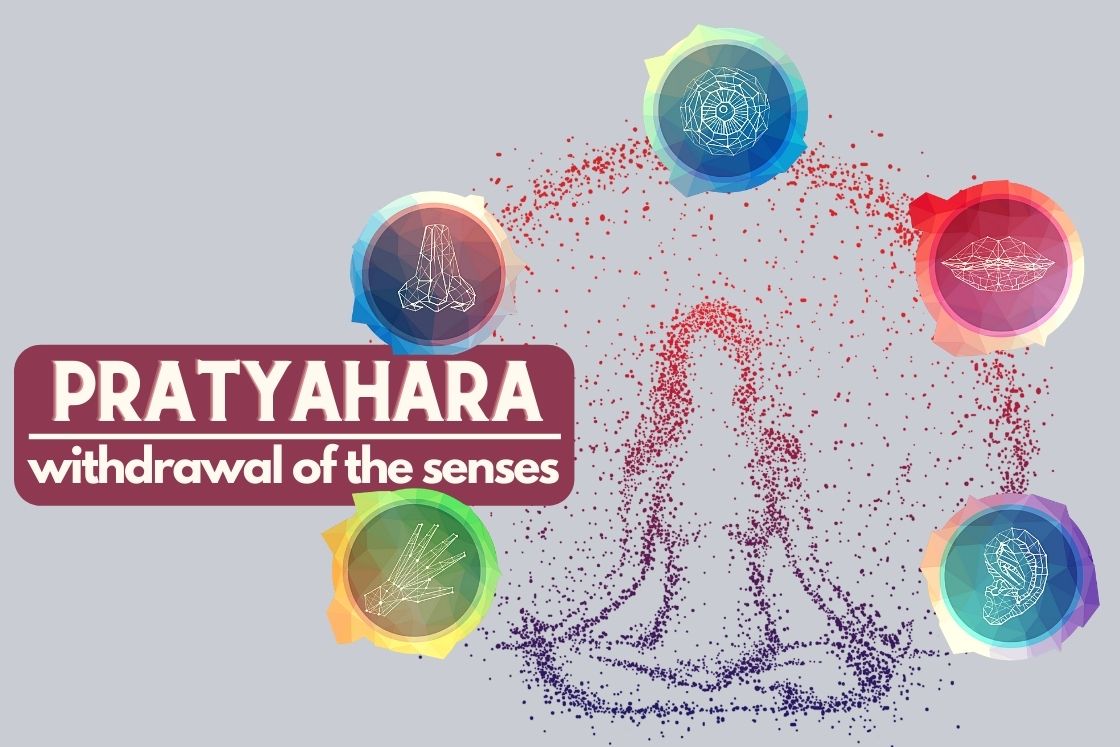
Pratyahara is the fifth limb of the eightfold path of yoga (Ashtanga Yoga) described by Patanjali. It means “withdrawal of the senses” and marks the turning level from exterior practices like posture and breath management to inside practices like focus and meditation.
In easy phrases, Pratyahara is the apply of turning your senses inward, away from exterior distractions, to organize the thoughts for deep meditation.
In yoga philosophy, there are 11 sense organs concerned on this course of:
- 5 organs of notion (Pancha Jnanendriyas): eyes, ears, nostril, tongue, and pores and skin
- 5 organs of motion (Pancha Karmendriyas): arms, ft, speech, excretory organs, and reproductive organs
- One inside sense: the thoughts (manas), which coordinates and interprets sensory enter
Amongst these, the thoughts is essentially the most highly effective. When the thoughts and senses are withdrawn from exterior objects, it turns into simpler to enter meditation and expertise inside stillness
Conventional definition of pratyahara
Within the Yoga Sutras of Patanjali, Pratyahara is launched in Chapter 2: Sadhana Pada, after the primary 4 limbs Yama, Niyama, Asana, and Pranayama.
svaviṣaya-asaṁprayoge cittasya svarūpānukāra iva indriyāṇāṁ pratyāhāraḥ
(Yoga Sutras 2.54)
This sutra could be interpreted as:
“Pratyahara is the withdrawal of the senses from their objects, simply because the thoughts withdraws from exterior impressions and displays its personal true nature.”
Right here, Maharishi Patanjali defines Pratyahara as a state the place the senses now not observe their typical outward path towards sensory objects. As a substitute, they flip inward, permitting the consciousness (Chitta) to relaxation in its personal nature. This inside withdrawal units the stage for true meditation (Dhyana).
Which means
The phrase Pratyahara is a Sanskrit time period composed of two components:
- Prati – that means in opposition to or away from
- Ahara – that means meals or consumption
In yogic context, Ahara refers not solely to bodily meals, but additionally to all the things we soak up by our sense organs sights, sounds, smells, tastes, and contact. Thus, Pratyahara actually means “withdrawal from what’s taken in”, or extra clearly, “withdrawal of the senses from exterior objects.”
In our each day lives, the senses (referred to as Jnanendriyas in yoga) are consistently engaged with the outer world:
- Eyes, ears, nostril, tongue, and pores and skin assist us understand exterior objects
- Organs of motion (Karmendriyas) just like the arms, ft, mouth, genitals, and anus assist us reply
This fixed interplay retains our consciousness externalized.
However within the apply of Pratyahara, we start to reverse this stream. As a substitute of reacting to the outer world, we gently redirect the senses inward. The thoughts turns into calm and begins observing what’s occurring inside ideas, feelings, breath, and inside vitality. This shift is important for getting into deeper states of meditation.
Pratyahara in actual world
Within the outer world, we’re consistently stimulated by sights, sounds, and experiences. However the inside world is of course calmer and extra peaceable. That’s why in yoga, we be taught to flip our consciousness inward that is the essence of Pratyahara.

The Turtle Analogy
A highly effective image of Pratyahara is the turtle. Simply as a turtle withdraws its limbs when it senses hazard, we too should be taught to withdraw our senses when overwhelmed by stress, anxiousness, or distractions.
On this case, our “limbs” are the 5 sense organs that preserve us linked to the exterior world. Pratyahara teaches us to softly pull these senses again, permitting the thoughts to relaxation in stillness.
Actual-World Examples of Pratyahara
Listed below are easy moments when you might have already practised Pratyahara with out figuring out it:
- You scent your favorite meals whereas working, however you keep targeted as a substitute of getting distracted.
- Somebody says one thing disagreeable, however as a substitute of reacting emotionally, you keep calm and reply properly.
- You stub your toe whereas strolling, however as a substitute of reacting with anger or ache, you merely observe the feeling and let it go.
In all these conditions, you have been not dominated by your senses you selected to remain in management. That is Pratyahara in motion.
Earlier than pratyahara begins

Within the eight limbs of yoga described by Patanjali, the trail begins with Yama, Niyama, Asana, and Pranayama. These are referred to as Bahiranga Yoga, or the exterior limbs, as a result of they contain self-discipline, posture, and breath practices rooted within the outer world.
The final 4 limbs Pratyahara, Dharana, Dhyana, and Samadhi are referred to as Antaranga Yoga, the inner limbs. These information the practitioner inward, towards psychological readability and religious stillness.
Pratyahara: The Bridge Between Physique and Thoughts
Pratyahara acts as a bridge between outer and inside practices. It prepares the thoughts to disconnect from exterior distractions and switch inward towards refined consciousness. However this inside journey can solely start when the physique and breath are regular, which is why the primary 4 limbs should be mastered earlier than Pratyahara can actually start.

Kevala Kumbhaka: The breath that results in pratyahara
The ultimate stage of Pranayama earlier than getting into Pratyahara is named Kevala Kumbhaka a spontaneous and easy retention of breath.
There are two kinds of Kumbhaka in yoga:
- Sahita Kumbhaka – Breath retention finished with effort and approach
- Kevala Kumbhaka – Pure breath suspension that occurs with out effort
Kevala Kumbhaka is taken into account an indication of mastery over breath. On this easy state, the breath turns into nonetheless, and so does the thoughts (Chitta).
As talked about within the Hatha Yoga Pradipika:
When the breath wanders the thoughts is also unsteady. However when the breath is calmed the thoughts too might be nonetheless.
The hyperlink between breath, thoughts, and senses
In yoga, breath governs the thoughts, and the thoughts directs the senses. So when the breath turns into calm and easy, the thoughts additionally quiets down. This state naturally results in withdrawal of the senses, or Pratyahara not by pressure, however by inside readiness.
On this calm state, the practitioner doesn’t react to sensory enter. The eye turns inward, and the outer world progressively fades into the background
What does sense withdrawal actually imply?

In yoga, sense withdrawal doesn’t imply shutting down your senses or avoiding interplay with the world round you. It is a frequent misunderstanding.
Pratyahara, the fifth limb of yoga, refers to a aware shift in consideration—the place the senses cease reacting to exterior stimuli and as a substitute stay underneath your management. It isn’t about eliminating sensory expertise however rising above it.
Detachment, not suppression
The true problem will not be the senses themselves however the attachment to sensory pleasure. We frequently lose consciousness after we take pleasure in what we see, hear, scent, style or contact. Over time, this fixed engagement with the exterior world pulls us away from inside consciousness.
In Pratyahara, sense withdrawal means detachment not suppression. You enable the senses to operate, however they now not distract or dominate your thoughts. Your consciousness stays inwardly targeted and your actions are now not dictated by exterior stimuli.
Actual-life examples of pratyahara
Listed below are some on a regular basis moments that replicate the apply of Pratyahara in motion:
- Staying targeted regardless of distractions
You discover the aroma of your favorite meals, however it doesn’t disturb your focus whereas working. - Responding as a substitute of reacting
In a heated argument, somebody says one thing adverse, but you keep calm and reply with consciousness relatively than reacting impulsively. - Letting go of bodily discomfort
Your toe hits a floor whereas strolling, however you rapidly return to composure with out overreacting to the ache.
In every of those circumstances, the senses are energetic, however they don’t pull your thoughts outward. That is the essence of Pratyahara the senses observe the thoughts, not the opposite means round. probably not needy, you had let go the conditions. It may be referred to as as Pratyhara in Abhayasa (course of).
The physique and thoughts in pratyahara
In each day life, our physique and thoughts consistently eat inputs each bodily and psychological. We feed on quick meals, espresso, social media, information, noise, ads, and infinite stimulation. All of this triggers our senses, resulting in restlessness and emotional exhaustion.
This exterior feeding requires a excessive quantity of metabolic vitality. Our senses are all the time energetic, searching for extra, reacting extra, and leaving us drained by the top of the day.
Turning Inward for nourishment
Within the state of Pratyahara, this course of reverses. As a substitute of drawing enter from the surface world, the physique and thoughts start to obtain vitality from inside. The senses now not chase stimulation; they turn into nonetheless, and consciousness turns inward.
This inside shift reduces sensory consumption and lowers metabolic exercise. Research and conventional accounts recommend that in deep yogic states, vitality use drops considerably. In truth, some yogis in India are mentioned to have lived for lengthy durations with out meals, water, and even breath for hours demonstrating the potential of inside vitality.
⚠️ Whereas these tales are extraordinary, Pratyahara will not be about reaching supernatural feats. Moderately, it exhibits the huge reservoir of vitality accessible after we disconnect from fixed sensory enter and hook up with the inside supply of vitality Prana (life pressure).
A glimpse of inside stillness
Once you really feel even a short second of inside calm free from exterior distractions you might be already experiencing the early stage of Pratyahara. On this state, your consciousness attracts vitality from the soul or larger self, relatively than from exterior stimuli.
In consequence, your thoughts turns into quieter, your physique extra rested, and your vitality extra targeted and refined.
Ultimate phrases
In each day life, a lot of what we think about good or unhealthy, proper or mistaken, and even joyful or unhappy, is formed by how our senses understand the world. When our senses prepared the ground, we regularly lose contact with our deeper self and turn into pushed by exterior experiences.
Pratyahara will not be about denying your needs or suppressing your will. As a substitute, it’s about growing the consciousness to tell apart between true wants and sensory cravings. It’s a apply of self-mastery studying to redirect the outward pull of the senses inward, towards the supply of calm and readability.
By calming the senses, you reclaim your vitality, focus, and peace. You might be now not a slave to exterior triggers, however a aware observer who chooses the place to direct consciousness.